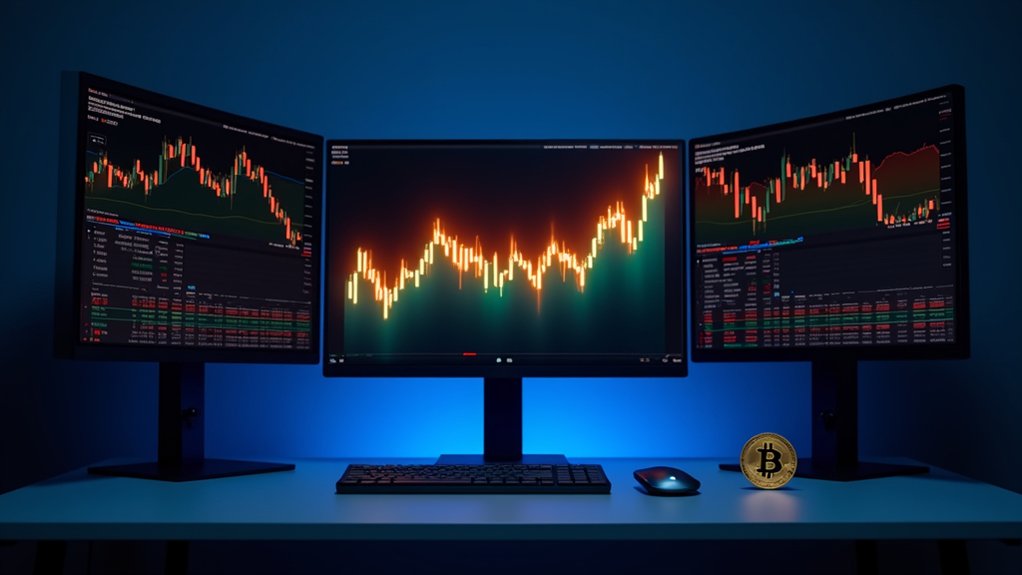Decentralization in cryptocurrency means there's no central authority like a bank controlling financial transactions. Instead, a network of computers worldwide manages and verifies crypto activities through distributed ledger technology. Smart contracts automatically execute agreements without middlemen, while consensus mechanisms guarantee security and transparency. This system gives users more control over their money and data, making transactions faster and censorship-resistant. The world of decentralized finance continues to evolve with new possibilities.

While traditional financial systems rely on banks and other middlemen, cryptocurrency's decentralization puts the power directly in users' hands. In a decentralized crypto system, there's no single authority controlling everything. Instead, the network spreads control across many different computers and participants around the world. These participants work together to verify and record transactions without needing anyone's permission. The system promotes trustless operations where users don't need to rely on faith in each other. The distribution of control enhances stakeholder participation across the entire network.
The backbone of decentralization is distributed ledger technology, where many copies of the same transaction records exist across the network. Special computer programs called consensus algorithms help everyone agree on which transactions are valid. The two main types are Proof of Work (PoW) and Proof of Stake (PoS). These systems use complex math and cryptography to keep everything secure and private. Consensus mechanisms promote transparency by ensuring all network participants can validate transactions. These mechanisms require majority agreement among nodes to prevent fraudulent activities like double spending.
One of decentralization's coolest features is smart contracts. These are like digital agreements that run automatically when certain conditions are met. There's no need for lawyers or other intermediaries to make sure everyone follows through. The code handles everything, making transactions faster and cheaper than traditional methods.
Decentralization offers several benefits that make it attractive. Since there's no single point of failure, it's harder for hackers to attack the network. Users have more control over their money and personal information. It's also harder for governments or other authorities to censor or block transactions. Plus, people who might not have access to regular banking services can participate in the crypto economy.
However, decentralization isn't perfect. Some blockchain networks struggle to handle lots of transactions quickly. Bitcoin's Proof of Work system uses a lot of electricity, which concerns environmentalists. Making decisions can also take longer when there's no central authority in charge. Different crypto projects have varying levels of decentralization, and some might be more centralized than they claim.
There's also uncertainty about how governments will regulate decentralized systems. Different countries have different rules, and these rules keep changing as the technology evolves. Despite these challenges, decentralization remains a core principle of cryptocurrency.
It's changing how people think about money, data ownership, and financial services. As the technology continues to develop, we're likely to see new solutions to current challenges and more ways that decentralization can benefit users.
Frequently Asked Questions
How Do Decentralized Networks Protect Against Cyber Attacks?
Decentralized networks protect against cyber attacks through multiple layers of security.
They don't have a single point of failure, so attackers can't take down the whole system by targeting one spot.
The networks use strong encryption and digital signatures to keep data safe.
They also rely on consensus mechanisms where many computers must agree before any changes are made.
Plus, there's built-in rewards for good behavior and penalties for bad actions.
What Happens if I Lose My Private Keys in a Decentralized System?
Losing private keys in a decentralized system means permanently losing access to one's crypto assets.
There's no central authority or help desk to reset or recover lost keys. It's like losing the only key to a vault – once it's gone, the contents are locked away forever.
The funds remain on the blockchain but can't be moved or used. Many people have lost millions in crypto this way.
Can Governments Regulate or Shut Down Decentralized Cryptocurrencies?
While governments can't completely shut down decentralized cryptocurrencies, they can make using them more difficult.
They're able to regulate crypto exchanges, block banking services, and restrict access points.
However, the decentralized nature of these networks means they'll continue running as long as people somewhere are operating nodes.
It's like trying to shut down the internet – governments can limit access, but can't stop it entirely.
How Does Network Speed Compare Between Centralized and Decentralized Systems?
When it comes to speed, centralized networks are usually faster because data travels through a single control point with shorter paths. They've got lower latency and can handle lots of traffic efficiently.
Decentralized networks tend to be slower since they process data across multiple nodes. However, decentralized systems scale better with increased network load and aren't as affected by single-point congestion issues.
Each type's speed depends heavily on its network design and bandwidth availability.
What Are the Environmental Impacts of Maintaining Decentralized Crypto Networks?
Decentralized crypto networks, especially those using proof-of-work like Bitcoin, have significant environmental impacts.
They consume massive amounts of electricity – about 0.55-0.7% of global power usage. Bitcoin mining alone creates 55 million tons of CO2 yearly, with a single transaction producing 300-400 kg of CO2.
There's also a notable water and land footprint.
However, newer proof-of-stake systems, like Ethereum's recent upgrade, use 99% less energy than traditional mining methods.





